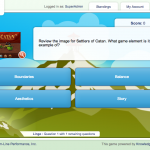GBL Picks: Curated Game Based Learning Resources

The Knowledge Guru team is obviously very interested in the future of game based learning, and right now that future is bright. But not everyone is as informed about the industry. We are setting out to change that. We’re on a mission to educate the Instructional Design community and the decision makers in Training and Development about game based learning and its true potential.
As part of that mission we’re bringing you GBL picks, a series of curated resources on game based learning and gamification. We’ll explain why each resource is important and how the information in them can be used to shape opinions on game based learning. So now, without further ado, here are this week’s GBL picks:
Pick #1
With a mobile boom, learning games are a $1.5B market headed toward $2.3B by 2017
We’ll start this GBL Picks off with some good news, Ambient Insight predicts the Serious Games market, which Ambient calls game-based learning, will grow from $1.5 billion in 2012 to $2.3 billion in 2017. The larger simulation-based learning market, which includes corporate training games, is expected to grow even more from $2.3 billion in 2012 to $6.6 billion in 2017. That’s significant for anyone who reads this blog because it’s more proof of the attitude shift that’s happening in the corporate world. No longer are we seeing higher-ups dismiss games as frivolous. Larger and larger companies are beginning to adopt game based learning. This is promising research for anyone on the fence about adopting their own game based learning solutions.
Pick #2
eLearning Guild Research: Got Game?
Next we’ll move on to some detailed research on games conducted by eLearning Guild. It highlights some examples of really effective gamification that is already being implemented. For example, Adobe has launched LevelUp, a free plugin that applies gamification to learning Photoshop. LevelUp lets new users go on a series of missions, such as reducing redeye and removing unwanted elements from their pictures. As the new users successfully complete each mission, they earn points and badges. You can see for yourself just what this looks like in the article. Another great example provided in the article is Hideki Narematsu, the human resources manager for McDonald’s in Japan, who uses games to train new hires and he says it cuts new-hire training time in half.
Pick #3
Dopamine and games – Liking, learning, or wanting to play?
Finally, our last article is an in-depth (very long) piece that analyses some of the chemical reactions in our brain as we play games, and differentiates between liking, learning, and wanting to play. It’s a great read for anyone who likes science, but for most of you the primary focus will be on the section titled “What does this mean for games?”. In it, the author breaks down some conclusions that could be made from these scientific experiments, like “Rewards that are unpredictable (loot drops) are generally more motivating than rewards that are predictable (100 xp per monster).” So it’s definitely worth at least skimming for anyone who’s interested in using games for learning.



